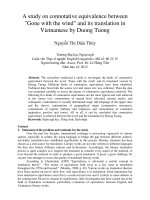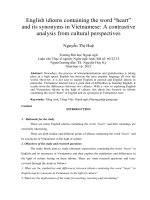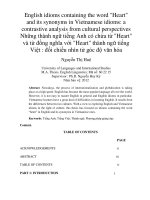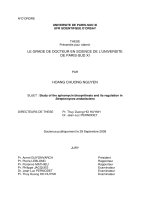English idioms containing the word “heart” and its synonyms in Vietnamese A contrastive analysis from cultural perspectives
Bạn đang xem bản rút gọn của tài liệu. Xem và tải ngay bản đầy đủ của tài liệu tại đây (316.32 KB, 10 trang )
English idioms containing the word “heart”
and its synonyms in Vietnamese: A contrastive
analysis from cultural perspectives
Nguyễn Thị Huệ
Trường Đại học Ngoại ngữ
Luận văn Thạc sĩ ngành: Ngôn ngữ Anh; Mã số: 60 22 15
Người hướng dẫn: TS. Nguyễn Huy Kỷ
Năm bảo vệ: 2012
Abstract: Nowadays, the process of internationalization and globalization is taking
place at a high speed. English has become the most popular language all over the
world. However, it is not easy to master English in general and English idioms in
particular. Vietnamese learners have a great deal of difficulties in learning English. It
results from the differences between two cultures. With a view to exploring English
and Vietnamese idioms in the light of culture, this thesis has focused on idioms
containing the word “heart” in English and its synonyms in Vietnamese ones.
Keywords: Tiếng Anh; Tiếng Việt; Thành ngữ; Phương pháp giảng dạy
Content
INTRODUCTION
1. Rationale for the study
There are many English idioms containing the word “heart” and their meanings are
extremely interesting.
There are both similar and different points of idioms containing the word “heart” and
its synonyms in Vietnamese in the light of culture.
2. Objectives of the study and research questions
The study firstly aims to study idiomatic expressions containing the word “heart” in
English and its synonyms in Vietnamese and then explore the similarities and differences in
the light of culture basing on these idioms. There are some research questions and issue
covered through the study as follows:
1. What are the similarities and differences between idioms containing the word “heart” in
English and its synonyms in Vietnamese in the light of culture?
2. What are the implications of the study for teaching, learning and translating?
2
3. Scope of the study
51 English idioms with the word “heart” and 148 Vietnamese idioms containing the
synonyms of “heart” are collected from many reliable dictionaries and taken to the study as a
source for contrasting.
4. Methods of the study
The main method applied in this thesis is contrastive analysis of idioms containing the
word “heart” in English and its synonyms in Vietnamese from cultural perspectives. The
steps to conduct the study include collecting, analyzing and contrasting.
5. Significance of the study
Having many synonyms of the word “heart” in Vietnamese such as “gan”, “tâm”,
“dạ”, “lòng”, “bụng”, “ruột” has created one significant point for the study. Secondly, the
study is not simply a contrastive analysis from linguistic perspectives.
6. Organization of the study
The study includes three main parts as follows:
Part 1 – Introduction –
Part 2 – Development – In this part, the researcher has elaborated two chapters:
Chapter 1 – Theoretical background and Literature Review
Chapter 2 – Similarities and differences of idioms containing the word “heart” and its
synonyms in Vietnamese in the light of culture
Part 3 – Conclusion
Following this part are the References and Appendices.
3
DEVELOPMENT
CHAPTER 1: THEORETICAL BACKGROUND
AND LITERATURE REVIEW
1.1. Theoretical background
1.1.1. Culture and the relationship between Language and Culture
1.1.1.1. Definitions of culture
UNESCO (United Nations Educational, Scientific and Culture Organization) gives
another definition of culture as follows:
Culture is a set of distinctive spiritual, material, intellectual and emotional features of
society or a social group, and that it encompasses, in addition to art and literature, lifestyles,
ways of living together, value systems, traditions and beliefs.
In my opinion, culture is the products of people, the characteristics of a particular group
of people, defined by everything including both spiritual and material features such as
language, religion, cuisine, social habits, music, arts, architecture and so on. The influence of
culture on human’s life is great and cannot be seen totally.
1.1.1.2. The relationship between language and culture
Language and culture always exist together and reinforce each other.
1.1.1.3. The relationship between language and proverbs, idioms
Proverbs and idioms are important parts in linguistic resources. They are proverbs and
idioms, which create the richness and beauty of a language.
1.1.2. Idioms
1.1.2.1. Definitions of idioms
An idiom is a number of words which taken together, meaning something different
from the individual words of the idioms when they stand- alone
1.1.2.2. Idioms versus proverbs
While a proverb is a complete sentence with a whole meaning making comments on
social relationships, imparting experience of life, giving lessons in morality or criticizing; an
idiom is a fixed phrase but not a complete sentence, so it is considered as a word.
1.1.2.3. Characteristics of idioms
Semantic characteristics
Syntactic characteristics
4
1.1.3. Idiomatic expressions containing the word “heart” in English and its synonyms in
Vietnamese
1.1.3.1. Literal and figurative meanings of “heart” and its synonyms in Vietnamese
“heart” has these following meanings ranking from the most frequently- used
meaning to the less one
(1): heart is the organ inside the chest, which controls the flow of blood by pushing it round
the body
(2): heart is used as the centre of a person’s feelings, especially of kind or sincere memory
(3): heart: is something in a shape supposed to be like the shape of a heart. A heart is used to
represent the love between a man and a woman
(4): heart: is used as the central of the most important part
(5): heart is used to refer to determination or strength of purpose
1.1.3.2 Idiomatic expressions containing the word “heart” and its synonyms in
Vietnamese
“Have a big heart, break your heart, follow heart” are examples of heart- based
idioms in English. In Vietnamese, there are more than one word to denote the most important
part in the body including “bụng, ruột, gan, tâm, dạ, lòng”. “ Tâm đầu ý hợp”, “ từ tận đáy
lòng”, “ dạ sắt gan vàng”, “ ruột tằm bối rối”, đi guốc trong bụng” are examples of
Vietnamese equivalents
1.1.4. Some characteristics of Vietnamese and English culture
1.1.4.1. Hofstede’s value dimensions
Individualism/Collectivism
High Uncertainty Avoidance – Low Uncertainty Avoidance
Power Distance
Masculinity/Femininity
Long-Term/Short-Term -
1.1.4.2. Characteristics of English and Vietnamese culture according to
Hofstede’s Value Dimension
Dimensions
Vietnamese
English
1.Individualism/
Collectivism
◊ Vietnam is considered a fairly
collectivist culture
- English belong to
individualism
2.High Uncertainty
- Vietnam is classified as a Low
- English tends to be high
5
Avoidance – Low
Uncertainty
Uncertainty Avoidance culture
uncertainty avoidance
3.Power Distance
-Vietnam is a social republic state
and has a high power distance.
- Low power distance
4.Masculinity/
Femininity
- Masculinity is highly valued in
Vietnam.
- Equal power in gender
5.Long-Term/
Short-Term
- Vietnam is high on long-term
orientation.
1.1.4.3. Other studies on English and Vietnamese culture
Regarding Hunt P.C (2002)
1.2. Literature Review
There have been a number of studies on similarities and differences between idioms in
English and Vietnamese in general and English idioms with “heart” and its synonyms in
Vietnamese from cultural perspectives in particular. Many researchers all over the world have
paid more attention to English idioms. Their opinions are collected and presented in many
idioms Dictionary such as Longman Dictionary of Language and Culture, Oxford Dictionary
of English Idioms.
1.3. Summary
CHAPTER 2: SIMILARITIES AND DIFFERENCES OF IDIOMS CONTAINING
THE WORD “HEART” AND ITS SYNONYMS IN VIETNAMESE IN THE LIGHT
OF CULTURE
2.1.Similarities
2.1.1. In terms of semantic
2.1.1.1. Expressing feelings: love, happiness, unhappiness
In English, many idioms containing the word “heart” show very deep feelings such as love,
happiness or unhappiness as follows:
+ break my heart + aching heart.
+ died of a broken heart + gives heart to somebody
Similar to English idioms, we can find many Vietnamese ones containing heart’s synonyms
(lòng, bụng, gan, ruột, tâm, dạ) to express the deepest feelings such as:
+ tận đáy lòng + bầm gan nát ruột
6
+ bấm bụng bấm gan + tím ruột bầm gan
2.1.1.2. Expressing determination and courage
Besides idioms to show love, happiness or unhappiness, there are also several idioms using
“heart” to refer courage or determination.
+Lose heart + Take heart
+ with all one`s heart + finds it in one's heart to
In Vietnamese, we can also find some idioms to express strong courage and determination.
+dạ sắt gan vàng + dạ ngọc gan vàng
2.1.1.3. Expressing people’s characteristics
“Heart” is also used to describe people’s characteristics. One person whose heart of gold is
very kind and helpful.
There are many idioms containing such words as “bụng” and “dạ” describing the nature of a
bad person who always speak the good things but in fact is heartless and wicked.
- Miệng bồ tát, dạ ớt ngâm
- Bụng chua miệng ngọt
2.1.2. In terms of syntax
According to Oxford Dictionary of English idioms by Cowie, Mackin and Caig, English
idioms with “heart” and Vietnamese idioms with heart’s synonyms have syntactic patterns as
shown below:
Syntactic
patterns
English
Vietnamese
Noun phrase
Heart of gold, heart of stone,
heavy heart
Gan đá dạ sắt, gan vàng dạ ngọc,
môt lòng một dạ
V+ Od
Break one’s heart, cross one’s
heart, open heart
Mát gan mát ruột, máu chảy ruột
mềm, ghi lòng tạc dạ
2.2. Differences
2.2.1. Individualism and collectivism in English and Vietnamese culture
. There are many heart- based idioms in which possessive determiners and possessive pronoun
tend to be exactly put before the word “ heart”. This feature somehow reflects individualism
in English society. In contrast, using possessive words does not exist in Vietnamese idioms in
general and idioms containing heart’s synonyms in particular. This feature, to some extent,
expresses one characteristic of Vietnamese people- that is collectivism.
2.2.2. English and Vietnamese language
7
Words in Vietnamese idioms can be changeable such as “ Ghi lòng tạc
dạ” or “ Tạc dạ ghi lòng”; “ dạ sắt gan vàng” or “ gan vàng dạ sắt”.
When studying heart- based idioms, it is noticeable that we rarely find an
English idiom containing the word “heart” and another word denoting different part of
human body.
English people use only the word “heart” to denote many concepts
whereas Vietnamese people have many words such as “gan, “ lòng” “ruột” “ tâm”, “bụng”,
“dạ”., sophistication and high evaluation to things and people. As hat.
Many Vietnamese idioms with the words “gan, “ lòng” “ruột” “ tâm”
are originated from old stories in the past.
In many Vietnamese idioms containing heart’s synonyms, there are not a
few to show strong determination and courage. This fact may result from Vietnamese’s long
history struggling against invaders. As a result, in order to get freedom, Vietnamese people
had to be courageous, determined and consistent. Therefore, idioms such as “Gan vàng dạ sắt,
gan đồng dạ sắt, lòng gang dạ thép, ghi tâm khắc cốt and so on appear much in Vietnamese
idioms.
In terms of syntax, English idioms with “heart” and Vietnamese ones
with heart’s synonyms have some different syntactic patterns as follows:
Syntactic
patterns
English
Vietnamese
Prepositional
phrase
After one’s own heart, at heart, by
heart, from the heart
No idiom
S + V
one’s heart is not in it
one’s heart is in one’s mouth
one’s heart sinks
one’s heart misses a beat
No idiom
2.3. Summary
CONCLUSION
1. Recapitualtion
After much exploration and consideration, this thesis has come to some major
findings. First of all, in terms of similarities, both English and Vietnamese use the word
“heart” and its synonyms to indicate the most important part in human body both physically
8
and mentally. Feelings such as love, happiness, sadness, determination or courage and
people’s characteristics are expressed through these kinds of idiom by both English and
Vietnamese. Some syntactic structures can be seen in idioms in both languages. Furthermore,
the study has found some differences in the light of culture between English and Vietnamese.
They are individualism and collectivism of English and Vietnamese culture, linguistic
differences. These differences result from the dissimilarities in culture such as people’s
characteristics, history’s origin and people’s way of thinking.
2. Limitations of the study
Despite being taken into much consideration by the author, this research paper still has
some unavoidable limitations as follows. Firstly, the study cannot deal with all aspects of
idioms in general and idioms containing the word “heart” in English and its synonyms in
Vietnamese in particular. Secondly, the study has only explored some major similarities and
differences in the light of culture between English and Vietnamese. In this study, the author
based on idioms with “heart” and its synonyms in Vietnamese as a tool; therefore, the results
could not reflect fully cultural features of English and Vietnamese.
3. Implications for teaching, learning and translating idioms in general
Firstly, teachers should provide some recognizable features of idioms for learners
because some students find it difficult to recognize idioms. Another important thing is that the
meanings of idioms cannot be guessed from its parts. Hence, teachers, when introducing an
idiom, should not only use it in given contexts but also explain clearly its figurative meaning.
For those who want to master idioms, they must firstly be hard working. They are advised to
learn by heart idioms because idioms have various structures and illogical in combinations.
Secondly, learner’s knowledge of mother tongue should be regularly enriched and widened.
Thirdly, understanding English culture is also necessary for understanding the similarities and
differences in the form of idioms between two nations.
As for translators, some following detailed hints are given. First, the translators should
use an idiom of similar meaning and form. Next, culture and language competence must be
enriched. It helps the translators come to the root of the idiomatic expressions instead of
attacking his minds to words and literal meaning. Last but not least, the translators should
enhance the skill of mobilizing appropriate translation methods. In fact, there are two
translation methods including communicative and semantic methods. In each situation, the
translator should take notice to find appropriate method.
4. Suggestions for further studies
9
Exploiting idioms in general and idioms in the light of culture in particular remains a
wide room to discuss and study. Further studies can get focus on other human- body parts in
English and Vietnamese idioms. Furthermore, beside English, other studies can explore the
differences between Vietnamese idioms and ones of other languages such as Chinese, Russian
and French.
References
In English
1. Agar, M. (1996), Language Shock. Understanding the Culture of Conservation,
HarperCollins Publisher.
2. Boas, M. (1989), An Introduction to English idioms, Oxford University Press.
3. Carthy, M. (2002), English Idioms in daily life, Oxford University Press
4. Cowie A.P., Mackin R., Mc Caig I.R. (1994), Oxford Dictionary of
English Idioms, Oxford University Press.
5. Curry, D. (1995), Illustrated American Idioms, Blackwell Publishing.
6. Edward B. Tylor (1871), Primitive Culture, Oxford University Press.
7. Hunt, P.C (2002), An Introduction to Vietnamese Culture.
8. Hornby A. S (1995), Oxford Advanced Learner’s Dictionary, Oxford: Oxford
University Press.
9. Hofstede, G. (2001), Culture’s consequences (2nd edition), Thousand Oaks, CA:
Sage.
10. Jackson & Amela and Palmer (2000), Idioms and Culture, Cambridge University
Press.
11. Jenifer and W Mordie (1978), English Idioms and How to Use, Oxford University
Press.
12. Kramsch (2000), English Idioms, Oxford University Press.
13. Longman Dictionary of Language Teaching and Applied Linguistics (1992).
14. Linton, N. (1989), Culture and Language, Cambridge University Press.
15. Oxford Student’s Dictionary of English (2001), pp.140.
16. Richard, W. (1990). Functions of Language. Oxford University Press.
17.
In Vietnamese
10
18. Đỗ Quỳnh Anh (2004), A contrastive analysis of English and Vietnamese Idioms of
Comparison, Luận văn thạc sỹ ngôn ngữ, Đại học Ngoại Ngữ- Đại học quốc gia Hà
Nội.
19. Nguyễn Du (1993), Truyện Kiều, Nxb Văn hóa
20. Nguyễn Thị Kim Huệ (2007), Vietnamese’s Cross- cultural Errors in using Idioms of
Comparisons in comparison with Anglicist”, Luận văn tốt nghiệp đại học, Đại học
Ngoại Ngữ- Đại học quốc gia Hà Nội.
21. Nguyễn Đình Hùng (1999), Tuyển tập thành ngữ, tục ngữ, ca dao Việt Nam thông dụng,
Nxb Văn hóa, Hà Nội.
22. Nguyễn Văn Khang & Bùi Như Ý (1994), Từ điển Thành ngữ Hoa-Việt, Nxb Văn hóa, Hà
Nội.
23. Nguyễn Quang (2001), Cross- cultural communication, Nxb Đại học quốc gia Hà Nội.
24. Nguyễn Lân (1993), Từ diển thành ngữ- tục ngữ Việt Nam, Nxb Văn học, Hà Nội.
25. Nguyễn Lực & Lương Văn Ðang (1993), Thành ngữ tiếng Việt, Nxb Khoa học xã hội, Hà
Nội.
26. Nguyễn Thị Phương (2009), Đặc trưng ngôn ngữ- văn hóa của các từ chỉ bộ phận con
người trong thành ngữ tiếng Việt (so sánh với tiếng Anh), Luận văn thạc sĩ ngôn
ngữ, Đại học Sư phạm thành phố Hồ Chí Minh.
27. Nguyễn Đức Tồn (1994), Tiếng gọi bộ phận cơ thể trong tiếng Việt với biểu trưng tâm lý,
tình cảm”, Tạp chí Văn hóa dân gian, Số 3.
28. Trần Quốc Vượng (1998), Cơ sở văn hóa Việt Nam, Nxb Văn học, Hà Nội.
29. Nguyễn Thị Quỳnh Yến (2003), Metaphors in English and Vietnamese human- body-
based Idioms, Luận văn tốt nghiệp đại học, Đại học Ngoại Ngữ- Đại học quốc gia
Hà Nội









